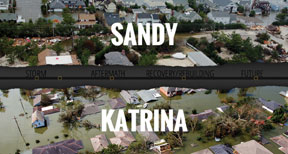 Hurricanes Katrina and Sandy: Disaster inequality
Hurricanes Katrina and Sandy: Disaster inequality
By Jazelle Hunt NNPA Columnist
WASHINGTON, D.C. (NNPA) – Just before Labor Day 2005, the world was stunned as images of Gulf Coast citizens, trudged through chaos and stagnant floodwaters, strewn with the debris of wrecked buildings and storm-tossed earth. The sights seemed to replay just before Halloween 2012, as coastal New York and New Jersey waded in icy waters and picked through the rubble of their destroyed property.
The incidents were separated by more than 1,300 miles, seven years, and two extreme weather events: Hurricane Katrina and Hurricane Sandy. But a new Web media project titled, Katrina/Sandy, juxtaposes the storms to suggest that disastrous scenes like these may be on repeat, as extreme weather becomes a new global reality.
“We’re not trying to say they’re the same event…. But it’s definitely a worthy thing to put [them] in context with each other when we think about, how do we respond better, how do we prepare better?” says Rachel Falcone, filmmaker, co-founder of Sandy Storyline (along with multimedia artist, Michael Premo), and co-creator of the Katrina/Sandy project.
“We’re trying to tell stories that can impact and improve the recovery after Sandy, or at least improve it so that…we learn from the mistakes we made during Sandy and especially during Katrina. And also the successes… not all the stories are sad stories. Communities are coming together to meet needs successfully and create solutions.”
Katrina/Sandy is the joint endeavor of two award-winning projects, Land of Opportunity and Sandy Storyline. Sandy Storyline is a crowd-sourced collection of Hurricane Sandy experiences, solicited and curated by a team of filmmakers. Land of Opportunity is a New Orleans-based multimedia project from a team of filmmakers that explores issues around housing; the Katrina/Sandy timeline is hosted as part of this larger project.
Created from donated foot-age and testimony from scores of local filmmakers and citizens around the country, Katrina/Sandy blends film, photography, and firsthand audio accounts into a powerful time-line before, during, and after the storms.
Viewers click points along the line and journey through foot-age of ravaging winds, relentless floodwaters, weatherworn residents, and weary homeowners. As the short films and accounts play, viewers can also segue to compelling documents, articles, and interviews that explore related issues.
In one scene from the Sandy accounts, a mother walks through her home, surveying gutted walls and detailing the bureaucratic ordeal of beginning the rebuilding process, as her young daughter wanders around calling out memories. In an accompanying scene from the Katrina footage, a father reflects on the 18 months he and his family have lived in a trailer on his property, waiting for the city to demolish his crumbling house so he can re-build, as his young son plays nearby.
The similarities continue to unfold in straightforward, powerful vignettes. Notably, low-income residents share similar experiences of isolation and neglect. In Sandy’s wake, it is elderly and disabled people stuck in high-rise public housing units without electricity, heat, or medications. Post-Katrina, it is mostly Black people slogging through hazardous floodwaters, searching for food and dry clothing.
